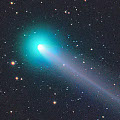
|
It passed only 0.4 A.U. from the earth, and 0.8 A.U. from the sun in November and December, and brightened up to 4.7 mag (Nov. 28, Juan Jose Gonzalez). Now it is 8.1 mag (Feb. 1, Chris Wyatt). In the Northern Hemisphere, it keeps observable in excellent condition for a long time until 2014 autumn when the comet will fade out. It is appearing in the morning sky again also in the Southern Hemisphere, and it keeps observable in good condition after this.
Date(TT) R.A. (2000) Decl. Delta r Elong. m1 Best Time(A, h)
Feb. 1 18 11.63 7 55.9 1.482 1.102 48 8.2 5:32 (282, 30)
Feb. 8 18 18.15 5 51.4 1.529 1.188 50 8.7 5:27 (287, 32)
|
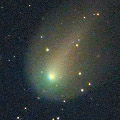
|
Although it was predicted to be 14 mag, it brightened up to 8 mag in outburst in mid October. After it became diffuse and faint, it turned to be brightening again. Now it is bright as 8.7 mag (Feb. 1, Chris Wyatt). It keeps 8-9 mag for a long time until early summer, and it keeps observable in the morning sky in the Northern Hemisphere. In the Southern Hemisphere, it is getting higher and it will be observable in excellent condition after spring.
Date(TT) R.A. (2000) Decl. Delta r Elong. m1 Best Time(A, h)
Feb. 1 18 1.75 5 8.4 2.094 1.623 48 8.3 5:32 (286, 30)
Feb. 8 18 21.87 3 53.8 2.069 1.610 49 8.2 5:27 (288, 30)
|

|
Now it is bright as 12.5 mag (Feb. 1, Chris Wyatt). It is expected to brighten up to 5-6 mag in 2014 autumn. In the Northern Hemisphere, it will be getting higher gradually after this, and it keeps observable in good condition for a long time. It keeps locating low in the Southern Hemisphere.
Date(TT) R.A. (2000) Decl. Delta r Elong. m1 Best Time(A, h)
Feb. 1 16 34.24 13 47.6 3.302 3.140 71 11.6 5:32 (296, 52)
Feb. 8 16 36.00 15 1.5 3.117 3.061 77 11.3 5:27 (300, 57)
|

|
It brightened very rapidly in mid November, from 15 mag to 9 mag only within a week. Now it is bright as 10.7 mag but diffuse (Jan. 4, Carlos Labordena). It will be fading after this. It is observable in excellent condition in the Northern Hemisphere. It keeps locating extremely low in the Southern Hemisphere.
Date(TT) R.A. (2000) Decl. Delta r Elong. m1 Best Time(A, h)
Feb. 1 11 23.26 49 32.6 1.029 1.870 136 11.8 2:40 (180, 76)
Feb. 8 11 19.56 51 46.1 1.088 1.930 136 12.0 2:09 (180, 73)
|

|
First return of a new periodic comet discovered in 1998. It brightened up to 10 mag at the discovery. Now it is 12.7 mag (Jan. 28, Chris Wyatt). A bit fainter than originally expected. But in the Northern Hemisphere, it keeps observable in excellent condition from autumn to spring. It locates somewhat low in the Southern Hemisphere.
Date(TT) R.A. (2000) Decl. Delta r Elong. m1 Best Time(A, h)
Feb. 1 6 12.73 31 18.2 1.338 2.188 140 12.1 21:27 ( 0, 86)
Feb. 8 6 12.75 29 39.4 1.378 2.178 133 12.1 20:59 ( 0, 85)
|

|
It will pass the perihelion on Feb. 15, and will brighten up to 12 mag. Now it is not observable. It will appear in the evening sky in mid February in the Northern Hemisphere, or in early March in the Southern Hemisphere. Then it keeps observable while the comet will fade out very rapidly.
Date(TT) R.A. (2000) Decl. Delta r Elong. m1 Best Time(A, h)
Feb. 1 22 8.00 -11 35.8 1.529 0.666 18 13.2 18:54 ( 76, 0)
Feb. 8 22 47.71 -9 18.9 1.436 0.624 20 12.5 19:00 ( 77, 2)
|
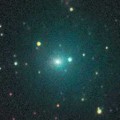
|
It brightened very rapidly, and brightened up to 10.5 mag from autumn to winter. It is bright as 11.8 mag still now (Dec. 29, J. P. Navarro Pina). It will be fading after this. In the Northern Hemisphere, it keeps observable in excellent condition until May when it becomes fainter than 18 mag. It will not be observable after this in the Southern Hemisphere.
Date(TT) R.A. (2000) Decl. Delta r Elong. m1 Best Time(A, h)
Feb. 1 1 9.62 26 54.8 1.657 1.702 75 12.6 18:54 ( 86, 57)
Feb. 8 1 29.96 28 30.5 1.728 1.728 73 13.1 19:00 ( 91, 55)
|
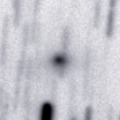
|
It brightened up to 2 mag by unusual major outburst in 2007. It is coming back now. It will be 14 mag at best by normal prediction. But actually, it is already very bright as 13.5 mag (Nov. 25, Hidetaka Sato). Now it is not observable. It will appear in the morning sky in May.
Date(TT) R.A. (2000) Decl. Delta r Elong. m1 Best Time(A, h)
Feb. 1 21 44.20 -12 53.5 3.054 2.101 12 13.7 18:54 ( 79, -6)
Feb. 8 21 58.67 -10 59.5 3.058 2.090 9 13.6 19:00 ( 83, -9)
|

|
It brightened up to 11-12 mag in 2012. Now it is 14.0 mag (Dec. 31, Taras Prystavski). It will be observable in good condition at 14 mag until 2014 early summer.
Date(TT) R.A. (2000) Decl. Delta r Elong. m1 Best Time(A, h)
Feb. 1 13 19.14 -14 29.5 6.682 7.050 108 13.8 4:36 ( 0, 40)
Feb. 8 13 15.44 -14 21.2 6.596 7.083 115 13.8 4:05 ( 0, 41)
|

|
Now it is 12.8 mag and visible visually (Dec. 5, Juan Jose Gonzalez). It keeps 13-14 mag and observable in good condition in the Northern Hemisphere for a long time from 2013 to 2014. In the Southern Hemisphere, it is not observable until 2014 autumn.
Date(TT) R.A. (2000) Decl. Delta r Elong. m1 Best Time(A, h)
Feb. 1 23 21.74 65 30.0 3.368 3.461 87 13.9 18:54 (150, 42)
Feb. 8 23 34.10 63 10.9 3.461 3.468 82 13.9 19:00 (147, 40)
|

|
Now it is 14.4 mag (Jan. 28, iTelescope Observatory, Siding Spring).
Date(TT) R.A. (2000) Decl. Delta r Elong. m1 Best Time(A, h)
Feb. 1 15 47.59 -29 3.3 6.417 6.167 70 14.0 5:32 (338, 22)
Feb. 8 15 50.76 -29 21.2 6.307 6.165 77 13.9 5:27 (343, 23)
|
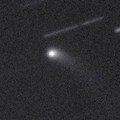
|
Now it is 13.9 mag and visible visually (Feb. 1, Chris Wyatt). It keeps 14 mag for a long time until 2014 summer. It keeps observable in good condition in the Northern Hemisphere. It is observable only until February in the Southern Hemisphere.
Date(TT) R.A. (2000) Decl. Delta r Elong. m1 Best Time(A, h)
Feb. 1 2 41.39 17 55.0 1.668 1.961 91 14.0 18:54 ( 42, 69)
Feb. 8 2 39.46 21 11.2 1.727 1.915 85 14.0 19:00 ( 63, 65)
|
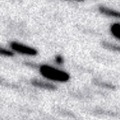
|
It reaches up to 12 mag in 2014 spring. But the condition in this apparition is bad. It locates low around the brightest days. Now it is 15.5 mag (Dec. 20, F. Garcia). It is already unobservable in the Southern Hemisphere. It will be unobservable soon also in the Northern Hemisphere.
Date(TT) R.A. (2000) Decl. Delta r Elong. m1 Best Time(A, h)
Feb. 1 22 19.82 -6 35.4 2.886 2.014 22 14.2 18:54 ( 79, 5)
Feb. 8 22 35.33 -5 24.2 2.878 1.978 19 14.0 19:00 ( 82, 2)
|
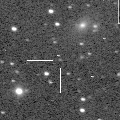
|
Already bright as 14.4 mag (Jan. 3, Mt. Lemmon Survey). It will brighten up to 13 mag and to be observable in excellent condition from spring to summer.
Date(TT) R.A. (2000) Decl. Delta r Elong. m1 Best Time(A, h)
Feb. 1 13 48.97 -12 27.3 2.339 2.722 102 14.2 5:05 ( 0, 42)
Feb. 8 13 54.88 -12 51.8 2.235 2.704 107 14.0 4:44 ( 0, 42)
|

|
Now it is 12.9 mag (Nov. 27, Sandor Szabo). It keeps bright at 13-14 mag for a long time until 2014. It keeps observable for a long time in the Northern Hemisphere, although it becomes unobservable temporarily in January. In the Southern Hemisphere, it keeps unobservable until March.
Date(TT) R.A. (2000) Decl. Delta r Elong. m1 Best Time(A, h)
Feb. 1 19 45.35 4 52.3 7.021 6.172 28 14.1 5:32 (270, 9)
Feb. 8 19 47.87 4 42.7 7.008 6.187 31 14.1 5:27 (273, 13)
|

|
Now it is 14.4 mag and visible visually (Jan. 30, Chris Wyatt). It is expected to brighten up to 7.5 mag and to be observable in excellent condition from summer to autumn in 2014 in the Southern Hemisphere. The condition is bad in the Northern Hemisphere. It will pass extremely close to Mars in 2014 October.
Date(TT) R.A. (2000) Decl. Delta r Elong. m1 Best Time(A, h)
Feb. 1 2 51.21 -35 13.6 3.722 3.664 78 14.2 18:54 ( 11, 19)
Feb. 8 2 46.19 -34 7.9 3.746 3.594 73 14.1 19:00 ( 19, 18)
|
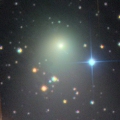
|
It became much brighter than expected, and reached up to 8.5 mag (Aug. 15, Alexandre Amorim). Now it is fading, but it is bright as 12.8 mag still now (Jan. 5, Taras Prystavski). In the Southern Hemisphere, it will keep observable in good condition for a long time until 2014 summer when the comet fades out. It will never be observable again in the Northern Hemisphere.
Date(TT) R.A. (2000) Decl. Delta r Elong. m1 Best Time(A, h)
Feb. 1 16 34.10 -67 53.3 2.929 2.667 65 14.5 5:32 (347,-16)
Feb. 8 16 47.52 -68 20.0 2.942 2.737 68 14.7 5:27 (348,-16)
|
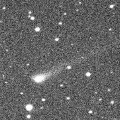
|
It keeps bright as 13-14 mag for a long time from 2013 to 2014. Although it had been unobservable for a while, it is appearing in the morning sky now.
Date(TT) R.A. (2000) Decl. Delta r Elong. m1 Best Time(A, h)
Feb. 1 18 44.41 -26 39.7 3.858 3.068 32 14.7 5:32 (305, 2)
Feb. 8 18 56.31 -26 37.8 3.801 3.065 36 14.7 5:27 (306, 3)
|

|
Big asteroid discovered in 1906. It suddenly showed the cometary activity on Dec. 11, 2010, probably due to an impact of a small object. It has already turned to be stellar.
Date(TT) R.A. (2000) Decl. Delta r Elong. m1 Best Time(A, h)
Feb. 1 0 48.31 -5 9.0 3.654 3.237 57 15.1 18:54 ( 54, 33)
Feb. 8 0 55.25 -3 59.9 3.745 3.245 52 15.1 19:00 ( 61, 29)
|
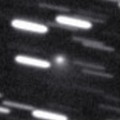
|
Now it is 14.8 mag (Dec. 31, Taras Prystavski). It keeps 15 mag until March, and will be observable in excellent condition in the Northern Hemisphere. It locates low in the Southern Hemisphere.
Date(TT) R.A. (2000) Decl. Delta r Elong. m1 Best Time(A, h)
Feb. 1 4 23.50 35 46.1 1.125 1.803 117 15.4 19:38 (180, 89)
Feb. 8 4 33.41 34 55.7 1.167 1.792 112 15.4 19:21 ( 0, 90)
|

|
It brightened up to 14.0 mag from spring to summer in 2013 (June 11, Sandor Szabo). Now it is 15.4 mag, much brighter than origianlly predicted (Jan. 10, Ken-ichi Kadota). In the Northern Hemisphere, it will be observable at 15-16 mag in excellent condition until spring. It locates somewhat low in the Southern Hemisphere.
Date(TT) R.A. (2000) Decl. Delta r Elong. m1 Best Time(A, h)
Feb. 1 13 44.38 13 45.7 3.638 4.097 111 15.4 5:01 ( 0, 69)
Feb. 8 13 39.88 15 53.4 3.565 4.133 118 15.4 4:29 ( 0, 71)
|
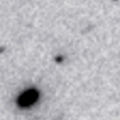
|
It is expected to brighten up to 13 mag and to be observable in good condition in 2015. Now it is 16.5 mag (Jan. 11, Ken-ichi Kadota). In 2014, it will be observable at 15 mag in good condition from winter to summer.
Date(TT) R.A. (2000) Decl. Delta r Elong. m1 Best Time(A, h)
Feb. 1 13 57.41 -4 48.6 4.841 5.149 102 16.0 5:14 ( 0, 50)
Feb. 8 13 59.38 -4 41.8 4.694 5.106 109 15.9 4:48 ( 0, 50)
|
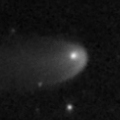
|
Now it is 14.6 mag (Dec. 29, Taras Prystavski). It will be fading after this, but it keeps brighter than 18 mag until 2015 spring.
Date(TT) R.A. (2000) Decl. Delta r Elong. m1 Best Time(A, h)
Feb. 1 3 4.46 -17 53.8 7.689 7.690 86 16.0 18:54 ( 11, 37)
Feb. 8 3 4.31 -17 0.4 7.821 7.724 80 16.1 19:00 ( 21, 36)
|
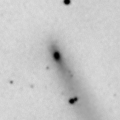
|
Now it is 15.6 mag (Jan. 9, Hidetaka Sato), brighter than origianlly predicted. It will be observable at 14-16 mag for a long time from 2013 to 2014.
Date(TT) R.A. (2000) Decl. Delta r Elong. m1 Best Time(A, h)
Feb. 1 15 55.06 -21 49.2 4.191 3.974 70 16.1 5:32 (334, 28)
Feb. 8 16 0.82 -22 15.8 4.101 3.985 76 16.0 5:27 (338, 29)
|

|
Now it is 17.2 mag (Jan. 10, Ken-ichi Kadota). It brightens up to 15.5 mag from spring to summer, and will be observable in excellent condition in the Southern Hemisphere. It locates somewhat low in the Northern Hemispehre.
Date(TT) R.A. (2000) Decl. Delta r Elong. m1 Best Time(A, h)
Feb. 1 8 9.70 -24 38.1 1.689 2.498 136 16.6 23:22 ( 0, 30)
Feb. 8 8 4.23 -25 12.5 1.647 2.447 135 16.5 22:50 ( 0, 30)
|

|
Now it is 16.3 mag (Dec. 31, Taras Prystavski). It keeps 16 mag for a long time until 2015 summer. It keeps observable in good condition in the Northern Hemisphere. It becomes observable only after 2015 in the Southern Hemisphere.
Date(TT) R.A. (2000) Decl. Delta r Elong. m1 Best Time(A, h)
Feb. 1 4 36.93 53 21.8 3.640 4.201 118 16.5 19:51 (180, 72)
Feb. 8 4 36.33 53 12.8 3.687 4.168 112 16.5 19:23 (180, 72)
|

|
Now it is 17.0 mag (Jan. 24, A. Klotz, F. Kugel). It keeps close to the earth around 0.7 a.u. until spring. It will brighten up to 16.5 mag in February and March, and will be observable in excellent condition in the Northern Hemisphere. It locates very low in the Southern Hemisphere.
Date(TT) R.A. (2000) Decl. Delta r Elong. m1 Best Time(A, h)
Feb. 1 1 53.25 28 49.3 0.669 1.142 84 16.7 18:54 ( 82, 67)
Feb. 8 2 19.07 30 46.8 0.655 1.126 84 16.6 19:00 ( 88, 66)
|

|
It approached to the sun down to 0.73 A.U. on 2013 Mar. 24, and brightened up to 4.7 mag (Mar. 11, Michael Mattiazzo). Now it is fading. It has already faded down to 16.5 mag (Jan. 1, G. Dangl). In the Northern Hemisphere, it keeps observable in good condition while fading gradually. In the Southern Hemisphere, it will never be observable again.
Date(TT) R.A. (2000) Decl. Delta r Elong. m1 Best Time(A, h)
Feb. 1 20 29.16 51 19.3 4.715 4.455 68 16.6 5:32 (223, 25)
Feb. 8 20 36.90 52 10.5 4.802 4.528 68 16.7 5:27 (224, 27)
|
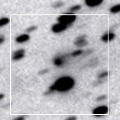
|
Now it is 15.4 mag (Dec. 30, Taras Prystavski). It tends to be brightest 4 months after the perihelion passage. However, it will be fading after this, and will be fainter than 18 mag in March.
Date(TT) R.A. (2000) Decl. Delta r Elong. m1 Best Time(A, h)
Feb. 1 5 54.07 21 57.1 1.637 2.450 136 16.8 21:08 ( 0, 77)
Feb. 8 5 54.43 22 21.3 1.735 2.485 129 17.0 20:41 ( 0, 77)
|

|
Now it is 17.2 mag (Jan. 12, P. C. Sherrod). It will approach to the earth down to 0.68 a.u., brighten up to 16 mag, and will be observable in excellent condition in spring.
Date(TT) R.A. (2000) Decl. Delta r Elong. m1 Best Time(A, h)
Feb. 1 12 35.44 30 41.9 0.970 1.764 128 17.0 3:52 ( 0, 86)
Feb. 8 12 32.11 29 36.3 0.900 1.742 134 16.8 3:21 ( 0, 85)
|
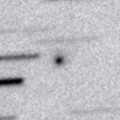
|
Now it is 16.6 mag (Jan. 7, Toshiyuki Takahashi). It is expected to brighten up to 6 mag in 2014 autumn. At this time, it keeps observable while brightening gradually until April when it becomes 16 mag.
Date(TT) R.A. (2000) Decl. Delta r Elong. m1 Best Time(A, h)
Feb. 1 5 37.15 21 45.9 2.969 3.710 132 17.1 20:50 ( 0, 77)
Feb. 8 5 26.81 21 24.0 2.992 3.629 123 17.0 20:13 ( 0, 76)
|
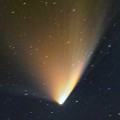
|
It passed the perihelion on 2013 Mar. 10, and brightened up to 0-1 mag. Now it is fading. It has already faded down to 15.8 mag (Jan. 15, Ken-ichi Kadota). It will keep 16-17 mag until spring. It is not observable in the Southern Hemisphere.
Date(TT) R.A. (2000) Decl. Delta r Elong. m1 Best Time(A, h)
Feb. 1 17 15.42 28 2.4 5.193 4.947 70 17.0 5:32 (268, 51)
Feb. 8 17 18.16 28 44.4 5.201 5.021 74 17.1 5:27 (269, 56)
|
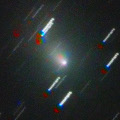
|
It brightened up to 9-10 mag in 2013 spring. Now it is fading. It has faded down to 15.8 mag in October (Oct. 7, Hidetaka Sato). In the Southern Hemisphere, it keeps observable for a long time until the comet fades out, although it keeps locating low. However, it has not been observed after November. It will never be observable again in the Northern Hemisphere.
Date(TT) R.A. (2000) Decl. Delta r Elong. m1 Best Time(A, h)
Feb. 1 17 16.16 -67 16.6 4.021 3.648 61 17.0 5:32 (343,-18)
Feb. 8 17 27.68 -67 39.4 4.030 3.716 64 17.2 5:27 (344,-18)
|
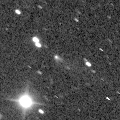
|
Now it is 17.4 mag (Jan. 4, Catalina Sky Survey). It keeps 17 mag for a long time from 2013 summer to early 2015.
Date(TT) R.A. (2000) Decl. Delta r Elong. m1 Best Time(A, h)
Feb. 1 2 5.14 13 48.1 3.019 3.044 82 17.2 18:54 ( 51, 60)
Feb. 8 2 12.20 14 14.7 3.111 3.040 76 17.2 19:00 ( 60, 56)
|

|
It brightened up to 12-13 mag from autumn to winter in 2012. Now it is fading. It has already faded down to 17.1 mag (Jan. 19, K. Hills). It keeps observable for a long time until March when the comet becomes fainter than 18 mag.
Date(TT) R.A. (2000) Decl. Delta r Elong. m1 Best Time(A, h)
Feb. 1 5 33.46 -2 16.7 4.358 5.003 126 17.3 20:47 ( 0, 53)
Feb. 8 5 32.60 -2 7.2 4.485 5.049 119 17.4 20:19 ( 0, 53)
|

|
It keeps 17-18 mag for a long time from 2013 to 2014. It is observable in excellent condition in the Southern Hemisphere. It is not observable in the Northern Hemisphere.
Date(TT) R.A. (2000) Decl. Delta r Elong. m1 Best Time(A, h)
Feb. 1 14 39.09 -47 30.1 4.755 4.692 80 17.6 5:32 (356, 7)
Feb. 8 14 35.71 -49 6.6 4.644 4.688 86 17.5 5:25 ( 0, 6)
|

|
Now it is 17.6 mag (Jan. 19, iTelescope Observatory, Mayhill). It will approach to the earth down to 0.06 a.u. from May to June, and it is expected to brighten up to 11 mag. In the Northern Hemisphere, it keeps observable in excellent condition until the highlight in late May while the comet will be brightening rapidly. In the Southern Hemisphere, it is not observable now. But it will be observable in mid May. Then it keeps observable in excellent condition at the highlight and after that while the comet will be fading.
Date(TT) R.A. (2000) Decl. Delta r Elong. m1 Best Time(A, h)
Feb. 1 8 57.38 64 34.0 0.732 1.576 132 17.7 0:16 (180, 61)
Feb. 8 8 39.50 67 33.7 0.697 1.513 127 17.6 23:24 (180, 57)
|
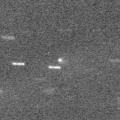
|
Now it is 18.3 mag (Jan. 6, Toshiyuki Takahashi). In this winter, it is observable at 17.5 mag in good condition until March.
Date(TT) R.A. (2000) Decl. Delta r Elong. m1 Best Time(A, h)
Feb. 1 10 52.47 10 31.9 1.620 2.529 151 17.6 2:09 ( 0, 65)
Feb. 8 10 48.21 10 52.1 1.599 2.546 159 17.6 1:38 ( 0, 66)
|

|
Fading rapidly. Now it is 15.7 mag (Jan. 5, Taras Prystavski). However, the central nucleus is so faint as 19.0 mag (Jan. 12, Martin Masek). It locates high in the Southern Hemisphere. But it will be too faint to observe soon. It locates extremely low in the Northern Hemisphere.
Date(TT) R.A. (2000) Decl. Delta r Elong. m1 Best Time(A, h)
Feb. 1 13 29.31 -45 50.4 2.355 2.586 92 17.6 4:46 ( 0, 9)
Feb. 8 13 27.70 -47 47.9 2.352 2.662 97 17.8 4:17 ( 0, 7)
|

|
First return of a new periodic comet which brightened up to 13 mag in outburst in 2008. It will be observable in good condition from spring to summer. But the brightness is uncertain. It was not detected, fainter than 21.0 mag on Jan. 6 (Jost Jahn).
Date(TT) R.A. (2000) Decl. Delta r Elong. m1 Best Time(A, h)
Feb. 1 12 46.68 9 18.7 1.997 2.674 123 17.9 4:03 ( 0, 64)
Feb. 8 12 48.48 9 50.1 1.908 2.655 130 17.6 3:37 ( 0, 65)
|

|
Now it is 17.4 mag (Jan. 15, A. Hidas). It is expected to brighten up to 14 mag from autumn to winter in 2015. The condition is excellent in the Southern Hemisphere, and it keeps observable for a long time after this while the comet will be brightening. In the Northern Hemisphere, it will be unobservable in late March.
Date(TT) R.A. (2000) Decl. Delta r Elong. m1 Best Time(A, h)
Feb. 1 5 30.12 -37 19.3 5.856 6.214 106 17.8 20:43 ( 0, 18)
Feb. 8 5 23.98 -36 17.5 5.870 6.172 103 17.7 20:10 ( 0, 19)
|

|
It keeps 18 mag for a very long time from 2013 to 2018. It locates high in the Southern Hemisphere. But it locates somewhat low in the Northern Hemisphere.
Date(TT) R.A. (2000) Decl. Delta r Elong. m1 Best Time(A, h)
Feb. 1 11 15.23 -19 29.6 8.712 9.376 130 17.9 2:32 ( 0, 35)
Feb. 8 11 13.82 -19 31.6 8.632 9.370 136 17.9 2:03 ( 0, 35)
|

|
Now it is 17.9 mag (Dec. 8, Hidetaka Sato). It will brighten up to 14 mag around the perihelion passage in 2019. In 2013, it will be observable in good condition at 18 mag from summer to winter. It locates low in the Southern Hemisphere.
Date(TT) R.A. (2000) Decl. Delta r Elong. m1 Best Time(A, h)
Feb. 1 2 41.33 27 3.6 13.310 13.421 94 17.9 18:54 ( 62, 75)
Feb. 8 2 41.58 27 6.7 13.400 13.392 87 17.9 19:00 ( 75, 69)
|
|
![]()
 154P/Brewington
154P/Brewington 17P/Holmes
17P/Holmes C/2006 S3 ( LONEOS )
C/2006 S3 ( LONEOS ) C/2011 J2 ( LINEAR )
C/2011 J2 ( LINEAR ) 29P/Schwassmann-Wachmann 1
29P/Schwassmann-Wachmann 1 C/2013 V1 ( Boattini )
C/2013 V1 ( Boattini ) 4P/Faye
4P/Faye 134P/Kowal-Vavrova
134P/Kowal-Vavrova C/2010 S1 ( LINEAR )
C/2010 S1 ( LINEAR ) C/2013 A1 ( Siding Spring )
C/2013 A1 ( Siding Spring ) C/2012 V2 ( LINEAR )
C/2012 V2 ( LINEAR ) 117P/Helin-Roman-Alu 1
117P/Helin-Roman-Alu 1 (596) Scheila
(596) Scheila 52P/Harrington-Abell
52P/Harrington-Abell C/2012 K6 ( McNaught )
C/2012 K6 ( McNaught ) C/2012 F3 ( PanSTARRS )
C/2012 F3 ( PanSTARRS ) C/2009 F4 ( McNaught )
C/2009 F4 ( McNaught ) P/2012 B1 ( PanSTARRS )
P/2012 B1 ( PanSTARRS ) C/2013 Y2 ( PanSTARRS )
C/2013 Y2 ( PanSTARRS ) C/2013 V2 ( Borisov )
C/2013 V2 ( Borisov ) P/2013 TL117 ( Lemmon )
P/2013 TL117 ( Lemmon ) C/2012 F6 ( Lemmon )
C/2012 F6 ( Lemmon ) 84P/Giclas
84P/Giclas 124P/Mrkos
124P/Mrkos C/2013 V5 ( Oukaimeden )
C/2013 V5 ( Oukaimeden ) C/2011 L4 ( PanSTARRS )
C/2011 L4 ( PanSTARRS ) C/2012 L2 ( LINEAR )
C/2012 L2 ( LINEAR ) 119P/Parker-Hartley
119P/Parker-Hartley C/2012 J1 ( Catalina )
C/2012 J1 ( Catalina ) C/2013 G7 ( McNaught )
C/2013 G7 ( McNaught ) 209P/LINEAR
209P/LINEAR 266P/2012 P1 ( Christensen )
266P/2012 P1 ( Christensen ) C/2013 N4 ( Borisov )
C/2013 N4 ( Borisov ) P/2008 J2 ( Beshore )
P/2008 J2 ( Beshore ) C/2014 A4 ( SONEAR )
C/2014 A4 ( SONEAR ) C/2013 C2 ( Tenagra )
C/2013 C2 ( Tenagra ) C/2010 U3 ( Boattini )
C/2010 U3 ( Boattini )![]()




































